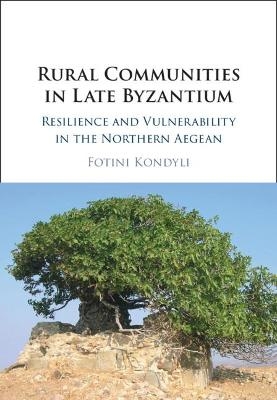
Rural Communities in Late Byzantium
Resilience and Vulnerability in the Northern Aegean
Seiten
2022
Cambridge University Press (Verlag)
978-1-108-84549-6 (ISBN)
Cambridge University Press (Verlag)
978-1-108-84549-6 (ISBN)
Uses an interdisciplinary approach combining new archaeological evidence with archival material to reconstruct the lives of rural communities in the Late Byzantine period in the face of economic, political, and demographic challenges. The emphasis on communities' social resilience contributes to a diachronic approach to crisis studies.
Late Byzantium faced economic, political, and demographic crises. This book argues for the ability of rural communities to transform their socioeconomic strategies and maintain resilience in the face of these, especially in the context of islands. It seeks to reinstate ordinary people in the historical narrative and reintroduce them as active participants in the events of the period, pointing to their ability not only to react to change, but also to initiate it. Combining new archaeological evidence with archival material pertaining to the islands of Lemnos and Thasos in the Northern Aegean, it provides concrete examples of Byzantine socio-economic strategies that successfully mitigated the various crises and thus contributes to a diachronic perspective on crisis management. The result is to rethink the nature of the Late Byzantine period, and to question the ways in which we have come to divide historical periods into 'good' or 'bad'.
Late Byzantium faced economic, political, and demographic crises. This book argues for the ability of rural communities to transform their socioeconomic strategies and maintain resilience in the face of these, especially in the context of islands. It seeks to reinstate ordinary people in the historical narrative and reintroduce them as active participants in the events of the period, pointing to their ability not only to react to change, but also to initiate it. Combining new archaeological evidence with archival material pertaining to the islands of Lemnos and Thasos in the Northern Aegean, it provides concrete examples of Byzantine socio-economic strategies that successfully mitigated the various crises and thus contributes to a diachronic perspective on crisis management. The result is to rethink the nature of the Late Byzantine period, and to question the ways in which we have come to divide historical periods into 'good' or 'bad'.
Fotini Kondyli is Associate Professor of Byzantine Archaeology and Art at the University of Virginia. Her research deals with Byzantine social and spatial practices and the archaeology of non-elites. She is the recipient of fellowships from Dumbarton Oaks Research Library and Collection, the Joukowsky Institute for Archaeology at Brown University, and the National Endowment for the Humanities.
1. In Search of Late Byzantine Rural Island Communities; 2. Who is Who in the Rural Landscape: The Makeup of Late Byzantine Rural Communities; 3. Pathways of Resilience; 4. Defending the Realm; 5. Community Building in the Face of Crisis: A Landscape Approach; 6. The Return of the People; Appendix I; Appendix II; Bibliography.
| Erscheinungsdatum | 18.03.2022 |
|---|---|
| Zusatzinfo | Worked examples or Exercises |
| Verlagsort | Cambridge |
| Sprache | englisch |
| Maße | 175 x 250 mm |
| Gewicht | 730 g |
| Themenwelt | Geschichte ► Allgemeine Geschichte ► Mittelalter |
| Geisteswissenschaften ► Geschichte ► Regional- / Ländergeschichte | |
| Sozialwissenschaften ► Soziologie | |
| ISBN-10 | 1-108-84549-5 / 1108845495 |
| ISBN-13 | 978-1-108-84549-6 / 9781108845496 |
| Zustand | Neuware |
| Haben Sie eine Frage zum Produkt? |
Mehr entdecken
aus dem Bereich
aus dem Bereich
eine neue Geschichte des Mittelalters
Buch | Hardcover (2023)
C.H.Beck (Verlag)
38,00 €


